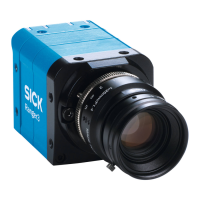Four-phase (dual-channel) encoder
The default definition of a pulse is a full four-phase cycle on the encoder inputs. This
gives a pulse counter that is robust to jitter and noise on the inputs. It is also possible
to use a high-resolution encoder pulse counting mode, where each flank on an encoder
input is counted. In this mode, a 4-times higher resolution is achieved, but in Direction
and Motion modes (see below) jitter on the input may lead to unwanted triggering.
A four-phase encoder can handle movements in both directions (forward and back‐
ward). The camera can be configured to react to the pulses in different ways, resulting
in different ways to trigger profiles. The different line triggering modes are illustrated
below.
Mode Parameter Description
Position EncoderOut‐
putMode =
PositionUp
or Position‐
Down
The encoder triggers a profile for each object position.
If the object has moved backward, no profiles are triggered until
the object has moved (at least) an equal distance forward.
PositionUp: "Forward" is defined as the positive direction.
PositionDown: "Forward" is defined as the negative direction.
Direction EncoderOut‐
putMode =
DirectionUp
or Direction‐
Down
The encoder triggers profiles when the object is moving forward.
If the object has moved backward, new profiles will be triggered as
soon as the object moves forward again.
DirectionUp: "Forward" is defined as the positive direction.
DirectionDown: "Forward" is defined as the negative direction.
Motion EncoderOut‐
putMode =
Motion
The encoder triggers profiles when the object is moving either
backward or forward.
Table 5: Triggering modes
Position
Direction
Motion
1 Moving forward 2 Moving backward 3 Moving forward again
Single-channel encoder
A single-channel encoder uses only one encoder channel. The input from the encoder
to the camera is a differential signal, and a profile is triggered each time the signal
goes high.
When a single-channel encoder is used, the camera cannot differentiate between
forward and backward movement. The single-channel encoder mode (EncoderMode =
SingleChannel) is therefore only visible and selectable when the EncoderOutputMode (see
table 5) is set to Motion.
State diagrams and trigger points
The encoder states and the possible transitions for a dual-channel encoder and a
single-channel encoder are shown in figure 35. The trigger point depends on the type of
encoder used:
CONFIGURATION 8
8020774/1D7Q/2022-03 | SICK O P E R A T I N G I N S T R U C T I O N S | Ranger3
47
Subject to change without notice

